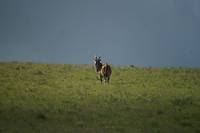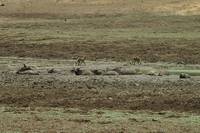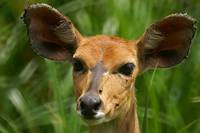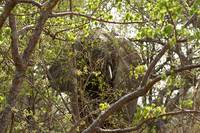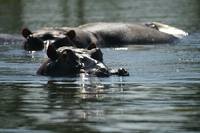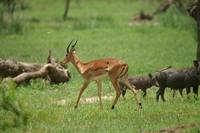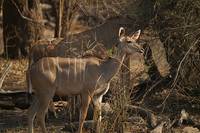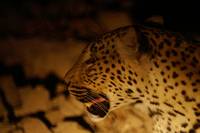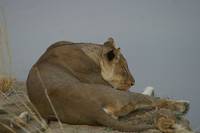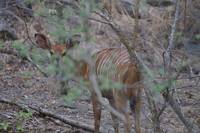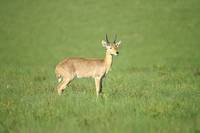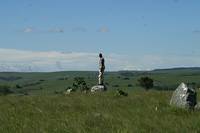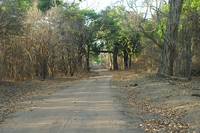
About National Parks and Nature Reserves in Malawi and Zambia
Nyika National ParkThe fascinating scenery of the mountain plateau at an altitude of up to 2,600m is rough and not typical African at all. The impressive landscape is dominated by rolling grasland with evergreen forest patches on the hillslopes. Some mammal and bird species that are rare in other places are commonly seen on the plateau. Activities of interest here include the night game drive, which offers the best chances to see leopard and serval; on day game drives excellent views over the vast plateau can be had; a walk in untouched evergreen forest.With over 3,000 sqkm this is one of the largest parks in Malawi, the plateau itself covers about three quarters of the park's total size.The rough climate at an altitude between 2,200 and 2,600 meters result in a habitat that differs significantly to that of lower regions. At least half a dozen species of orchids have been discovered that are endemic to the plateau. The evergreen forests are the last of their kind in Malawi that can be called untouched.Warthog, zebra, eland and roan antelope, reedbuck and bushbuck are commonly seen mammals. Other mammals include klipspringer, bushpig, several kinds of mongoose, the rare and possibly endemic red-and-blue mountain squirrel, blue and vervet monkeys and baboon. A herd of nine elephants has been living on the plateau for several years now.Bird live is exceptional. Numerous grassland specials are found as well as highland evergreen forest birds including Bar-tailed Trogon and White-chested Alethe. Just some of the most interesting birds that are commonly seen at least at times: Pallid Harrier; Red-winged Francolin; Denham's Bustard; Rwenzori Nightjar; Dusky Turtle-Dove; Angola and Blue Swallows; White-headed Saw-wing; Southern Mountain Greenbul; Brown Parisoma; Mountain Yellow and Cinnamon Bracken Warblers; Chapin's Apalis; Black-lored, Trilling and Churring Cisticolas; Waller's Starling; Ludwig's Double-collared Sunbird; Montane Widowbird; Southern Citril; Wattled Crane used to be common, but has been scarce over the last three years.
Activities on our safaris include day game drives and a night game drive; a walk in evergreen forestGame walks and mountain bike hire are available.
On our tours ususally we make use of the chalets at Chelinda Camp, which are comfortable, clean and efficient. They have a sitting and dining room with an open fire place, two twin bedrooms, a bathroom and a kitchen. Meals are prepared by the friendly caretaker.Another option to stay is the more luxurious Chelinda Lodge.
Liwonde National ParkThis is the most visited park in the country. With just under 1,000 sqkm rather small it holds good numbers of both, mammals and birds. This guarantees interesting game drives along the flood plain of the Shire River and in the mopane woodland that covers a great part of the park.Popular is the boat safari on the Shire River, a highlight not to be missed!Hippos, waterbuck, impala, warthog, baboon, vervet monkey and crocodiles are abundant. Elephant, bushbuck and kuku are numerous and can be seen at any time of year. A special of the park is the shy sable antelope, there is also a number of black rhino, very shy and only seen occasionally. Lion are rare visitors to the park, much better are the chances to see a herd of buffalos. Other mammals include hartebeest, zebra, eland, bushpig, common duiker, elephant shrew, squirrel and nocturnal species as genet, civet, hyena and several species of mongoose.Bird life is excellent. The large number of water-birds best seen on the boat safari are impressive. The birder will appreciate to find a number of interesting species. Böhm's Bee-eater is more abundant around the camp than anywhere else in the world; White-backed Night Heron and Pel's Fishing Owl are not uncommonly seen on the boat safari; Liwonde NP is the only place in Malawi where Brown-breasted Barbet and Lillian's Lovebird can be seen, the latter is quite common; so is Livingstone's Flycatcher; Racket-tailed Roller is occasionally found in mopane woodland.For accommodation there are two major options in this park that we make use of:Bushman's Baobabs Camp offers good value for money. It is situated just inside the park boundary. There is a variety of budget accommodation options in this lodge from dormitory over walk-in-tent with shared bathroom and enh suite walk-in-tent. We favour and ususally quote for the recently erected en suite chalets which are efficient and clean. Meals are usually tasty and sufficient. Canoe safaris and game walks are on offer as well as boat safaris.More popular, and more expensive, is the Mvuu Camp, which is situated in the middle of the park right on the banks of the Shire River. Accommodation is in comfortable en suite chalets, meals are good. One reason why this is one of the most popular lodges in the country is their ability to cope with large numbers of visitors, especially during the high season in July and August.Activities are all organised by the lodge and conducted by their skilled guides. The typical day here starts with a morning walk of one hour, followed by breakfast and a boat safari. After lunch there is time to enjoy the swimming-pool and after tea the afternoon/ night game drive comes up before a three course dinner ends the day at the camp.Next to Mvuu Camp is the Mvuu Lodge, a more luxurious option that offers some more privacy and some more personal attention than the Camp. Accommodation is in en suite safari tents overlooking a tributory of the Shire River which is frequented by hippos, crocodiles and various antelopes.
Majete Game ReserveThe Dutch organisation African Parks took over the management of this reserve in 2003 and since has been responsible for its developement. Large numbers of mammals were translocated into the reserve, namely more than 130 elephants from Liwonde, eight black rhino and recently six leopards and four lions.Majete is the only reserve in Malawi that holds the Big Five, but the visitor should not expect to see them at this early stage of development. And there is more to be seen. No other park in the country holds a variety of mammals as large as Majete does. Night game drives are on offer since August 2013, this increases the chance of spotting rhino, lion and leopard.Very popular with guests to this park is the spacious verandah in front of each tent. The tents are arranged in awide half-circle with a water-hole in a distance of about 50 meters. This water-hole is busy with animals day and night. Take a packet of pop-corn and a drink, place yourself in the comfy lean chair on the verandah and watch the wildlife come and drink and go; including rhino, elephant and buffalo.Game drives are best along the well-developed road system along the Shire River.The hilly park is covered in dry miombo woodland with some riparian forest along the banks of the Shire River.Elephant; hippo; crocodile; baboon; vervet monkey; waterbuck; impala and warthog are numerous as well as the nyala, which is found in Malawi only at the Lower Shire area. Hartebeest, kudu, bushbuck, eland, sable, zebra and buffalo or not uncommon. Reedbuck, roan antelope and common duiker are seen occasionally.Bird life is interesting. A small rocky island in the Shire River is the only breeding place in Malawi for rock pratincole. Usually the birds appear in August. Raptors are numerous. Böhm's Bee-eater is commonly seen in the riparian forest along the river. The miombo woodland holds some specials of this habitat such as racket-tailed roller.On our tours we usually make use of the Thawale Camp. It offers comfortable en suite safari tents with large verandahs from where a water-hole can be overlooked that is constantly visited by different species of mammals. The small number of tents guarantees a relaxed stay with a real safari feeling of being deep in the wild. Meals are ususally of good quality.
Lengwe National Park In contrast to Majete, more or less just around the corner, this park of rather flat topography is dominated by open grassland interspersed thick bush. Though the number of species in this park is somewhat limited, good numbers of game are to be seen on game drives.The park has got to offer something really special from about mid-August (until the rains start in November), when the supply of water is limited to a couple of water-holes. One of these holes is visible from the lodge's verandah and then usually busy all day, the other water-hole is even more interesting, since there is a look-out hide where one can sit and watch animals turn up from the bush one after another.Buffalo sightings seem to be even more common than in other parks; the rarely seen samango (or blue) monkey is seen occasionally and the nyala is commonly seen at its most northern natural distribution; the small and rare Suni is best seen at the waterholes. Other commonly seen mammals include impala, warthog, kudu, vervet monkey and baboon. Occasionally seen are bushpig, genet, civet, bushbaby, hyena. The pangolin is said to be present but rarely seen.Bird life: specials include crested guineafowl, but it is rarely seen; Böhm's and Mottled Spinetails; Böhm's Bee-eater is common. Lengwe is the only place in Malawi where a number of species is found, e.g. Grey Sunbird and Yellow-billed Hornbill. Raptors are numerous. A nest of White-backed Vulture can be seen on the way to the main hide.Accommodation is at the Italian run Nyala Lodge. Meals here are excellent and the spacious en suite chalets are spotless.Being just around the corner from Majete Game Reserve these two parks can ideally be combined in one tour.
Vwaza Marsh Game ReserveThis little-known reserve is situated along the access road to Nyika National Park and makes an ideal stop over on the long ride up the plateau. Of great interest for the visitor is a small lake, Lake Kazuni, one of only two water resources in the park. As a result of this fact, large numbers of game gather around the lake and can easily be spotted on game drives or even easier by just sitting at the lodge, which offers great views over Lake Kazuni. Hippos and birds are abundant. No other park offers that certain atmosphere of tranquility, the feeling of being deep in the bush. Especially towards the end of the dry season in no other park in the country can be seen as many elephants as in Vwaza; aside Kasungu National Park this is the only park in Malawi that holds the puku which is commonly seen; mopre common than in any other aprk in Malawi is also the tiny Sharpe's grysbok.The park is covered in miombo woodland, the road system is mainly maintained along the small lake, where most game gathers.Buffalos are frequently seen; kudus can be seen in larger numbers than in other park in the country; impala is common as well as warthog, vervet monkey and baboon. Crocodiles can often be seen from the lodge. Zebra and roan antelope are only seen occasionally. Night drives usually bring up bushbaby, different species of the mongoose family, elephant shrew; civet and genet.Birds: the area around Lake Kazuni is interesting and produces a good number of waterbirds, occasionally rare ones like Temminck's Courser; Lesser Black-winged Plover; Black-bellied Bustard can sometimes be seen on the airstrip. The real two specials of this park, White-winged Babbling Starling and Chestnut-mantled Sparrow-weaver are not found in the area of Lake Kazuni but at the other end of the park in mixed mopane and miombo woodland.Accommodation is in en suite safari-style chalets with view on Lake Kazuni at Kazuni Safari Lodge In contrast to rumours that say the opposite, the lodge is open. In 2012 it has been run by the government, and it is likely to be privatised in early 2013.
Lake Malawi National Park at Cape McLearThis park has been awarded a UNESCO world heritage site. This is due to the fact that the main part of the park is part of Lake Malawi, the underwater world is under protection. As a consequence of the fact that most of the park is under water there is not much to see for the visitor. On the small part of the park that is not covered by water only mammal species of small size are to be discovered such as rock and tree hyraxes; tree squirrel; vervet monkey and baboon. If you turn up early in the morning, place yourself on one of the rocks at otter point and watch the watersurface patiently, you may be rewarded with the sighting of an otter. Otter point is also a good spot to get a look on the protected cichlids that swim in between the rocks in the shallow water.The park is within walking-distance of Cape McLear village; unfortunately Golden Sands Lodge has not been operating for many years now.
Kasungu NPThe largest park of the country unfortunately is badly affected by heavy poaching. Kasungu NP still holds a large number of mammal species, possibly including such rare ones as wilddog and cheetah, but not much of this can be seen by the visitor.
Therefore a visit to this park and the beautiful Lifupa Lodge should not be done with the aim to see lots of game but to spend some time at a tranquil place in nature with spotless accommodation and good meals. The lodge is situated at an excellent setting overlooking Lifupa dam where hippos, pukus and impalas can be seen most of the time.Also other mammal species as elephants and kudus can occasionally be seen drinking at the dam. Game drives through the extensive miombo woodland are more for the scenery than for game, although you may be lucky and get to see some reedbucks, zebras, roan antelopes or even buffalos and elephants. Lesser elephant shrew is common around the lodge.
Nkhotakota GRThis game reserve has suffered from poaching possibly more than any other park.. However, a few mammals can still be found every now and then. The vast park probably still holds a couple of lions. The financing of an ambitious project of re-introducing animals into the reserve has just been granted and it can be expected that within a few years the situation will change to the better. At this early point of development a visit to this place should be done with the expectation to enjoy the quality of the camp and its services than in expectation of seeing any game.There are two palces to stay now inside the reserve: the upmarket Tongole Lodge and the Bua River Lodge. The latter is only some 10kms off the lakeshore road, situated at the Bua River it offers en suite safari tents and excellent meals, game walks can be done, bird-watching in the vicinity of the river and in the miombo woodland can be interesting. Pel's Fishing ,Owl as well as African finfoot are seen occasionally.
National Parks in Zambia
Parks of the Luangwa Valley
South Luangwa National ParkThe South Luangwa National Park is situated in the Luangwa Valley in the very east of Zambia. Why should you visit a park in Zambia on your holiday in Malawi? Because this is one of the great parks not only of the region but of the African continent together with the Serengeti and the Kruger National Park. Another good reason to visit this park from Malawi is the fact that it is much easier accessible from Malawi's capital Lilongwe than from Zambia's capital Lusaka.Please be aware that all non-African passport holders pay a visa fee of 50US$ per person to enter Zambia. You also might be asked to present a yellow fever vaccination card. This has been the case throughout 2011.
The size of the huge park exceeds 9,000sqkm covers a vast area of unspoilt nature and hosts large numbers of mammals and birds. Landscape is diverse, vegetated river banks, mopane woodland, teak forest and savannah are to be seen on game drives.The park is especially known for its excellent chances to spot leopards and lions; elephants are numerous and are commonly seen. Other commonly seen species include hippo, giraffe, buffalo, puku, kudu, impala, waterbuck, bushbuck, warthog, vervet monkey, baboon, several types of mongoose, genet, civet, hyena, porcupine; lesser and greater bushbabies; elephant shrews and Sharpe's grysbok. Wild dogs are occasionally seen as well as serval cats, honey badger and aardvark. Birders will enjoy the large number of waterbirds as well as some specials such as Lillian's lovebird, African skimmer or racket-tailed roller.The Mfuwe area offers a variety of lodges with prices from mid-range to high end. Out of a large variety of excellent places we usually make use of the excellent services of the Wildlife Camp for the reason that it is situated right at the river in a protected area. The camp is surrounded by indegenous mopane woodland; mammals cross the camp frequently an can be seen at any time at the banks of the Luangwa River just in front of the lodge. Accommodation is either in en suite walk-in-tents that offer splendid views over the Luangwa River or in en suite twin chalets.As most other camps Wildlife Camp offers a full board package that icludes all meals, afternoon tea as well as morning and night game drives, both of at least four hours. Other options for activities include full day drives in the main park or into the Nsefu Sector; guided game walks and a night in the bushcamp with guided morning and afternoon game walks.
General information about the Luangwa ValleyMost visitors to the Luangwa Valley only come to see the most popular park of that area, the South Luangwa park and many are not even aware that this is only one out three parks that exist in this vast nature area. As soon as one gets to the eastern side of the Luangwa River he leaves the busy part of the Luangwa behind. Flora and fauna along the Luangwa River do not differ much in these parks. The difference lies in the way of travelling. On the way to the Luambe and the North Luangwa Park it is likely that no other vehicle is met. A great part of the road, a one-way track, is in very good condition only sandy in places; there is a number of river crossings, but these cause problems only outside the rainy season.Leaving the Luangwa Valley towards Malawi means climbing the escarpement, not far but slow going on a path that can be quite bumpy in stages. The valley can be left either from Luambe or from North Luangwa, both tracks up the escarpement meet before you get to Lundazi which is the only large town on the way.After an approximately five to six hours drive the border-post is reached near the town of Jenda at the M1 on the Viphya Plateau.
The Luangwa Valley is only accessible in the dry-season in the monthd from June until October.
Nsefu SectorComing from Mfuwe the Luangwa River has to be crossed and soon the gate to the Nsefu Sector is to be passed. The Nsefu Sector still is part of the South Luangwa National Park and although the area holds large numbers of game and an interesting scenery it is little visited by game viewing vehicles from the lodges on the other riverside. Eland antelopes are found here, the flood plains of the river are always filled with fresh green grass and attract large numbers of waterbuck, puku, impala, kudu and also buffalo and elephant; lion and leopard sightings are not unusal. The saltpans are much visited by birds, a colony of crested crane is usually present; raptors, including several types of vulture, can often be seen up in the sky.On the way to the Luambe National Park there is enough time to explore the Nsefu Sector for several hours in the morning.
Luambe National ParkOn the way to the Luambe National Park the visitor has to cross this sector and it is well worth visiting. The view from the lodge on the river is spectacular. Luambe Wilderness Lodge is situated right at the bank of the river with usually large numbers of hippo resting just in front of the lodge. Sunsets are great from here.Interesting is the night game drive on a large game-filled plain, where the density of serval cat is high and several of these rare and shy predators might be seen on a single game drive. More difficult to be found are the Cookson's blue wildebeest, a sunbspecies that is endemic to the Luangwa Valley.The safari tents at the lodge are efficient, clean and comfortable, meals and service are very good especially if you put in account that you right in the middle of nowhere.
North Luangwa National Park Game viewing in the northern part is just as good as in the South Luangwa. The park is famous for its walking safaris and the high density of predators.Lion and leopard spottings are common, buffalos are numerous and even the Cookson's wildebeest is seen frequently.There are several options for accommodation, we usually stay at the recently opened Luangwa North Camp (the former Delia Camp); the chalets are buildt entirely from natural resources; meals are good. The view from the lodge on alrge stretch of the Luangwa River is spectaccular.
Kafue National ParkThis park is one of the largest protected areas not only in Africa but worldwide. With over 22,000sqkms its territory exceeds half the size of Switzerland. The size of the park ahs an influence on the way of exploring it. In other parks the vistor is used to go on game drive in the morning and afternoon; in the Kafue the travelling itself turns into a game drive. At least if one goes from the southern end heading north. If one leaves Livingstone at the Falls in the morning there is plenty of time to reach the first camp inside the park at Nanzhila Plains, as soon as the park boundaries are crossed there is game to be seen, especially on the plains. The same applies for the way to the Itezhitezhi Dam: leaving in the morning allows enough time to get to the lodge in the afternoon and have plenty of time to look at anything interesting on the way that turns up. A third day takes you to the xy area along the Lusaka- M road. Ideally one moves on every second day using the days in between for game drives to explore the area at the Nanzhila Plains, the Itezhitezhi Dam and at C. From the C area it is then about 3?? kms on good tarmac to Lusaka.
Crossing the Kafue Park in this way is an experience on its own, especially interesting for wildlife and nature enthusiasts.The Kafue Park is said to hold the largest number of antelope species in any park. Not uncommonly seen are impala; kudu; defassa waterbuck; bushbuck; sable and roan antelopes; but many other species such as common duiker; grysbok; oribi; lechwe; eland; hartebeest; wildebeest can be found as well; elephants are common as well as zebra and hippos in the rivers; a large variety of predators is present including lion; leopard; serval; hyena and jackal, but also wilddog and cheetah have been recorded in the park. Of the typical African mammals only giraffe and rhino do not occur in the park.Nanzhila Plains Lodge is an up-market place offering all the comfort one can expect; camping is also on offer; New Kalala Camp offers clean and efficient chalets and also camping right at the dam with a beautiful view over the water; at C there is a variety of lodges to choose from; Mukambi seems to be the most popular, nature freaks may enjoy the en suite walk-in-tents right at the river at ?? camp.We offer this tour only between early June and late October.
Lower Zambezi National ParkThe park covers a large area and holds good numbers of game especially along the Zambezi River. Game and scenery are well worth a visit to this park. From Chirundu, a border town between Zambia and Zimbabwe, a 50 kms dirt track leads through a so-called game management area. Along this road there are quite a few lodges situated right at the river offering beautiful views on the river. Unfortunately there is not much game to be seen in this area outside the park.Facts for the visitor: the game is inside the park and the mid-range lodges are outside the park... The lodges inside the park are up-market without exception, and so are the rates.The visitor who is not willing to spend more than 500 US$ per person per night only has got two choices: he either stays at one of the lodges outside the park, enoying the beautiful scenery of the Zambezi River and hopes for a game sight every now and then. Or he can go on a canoe safari for which this area is famous. These trips take minimum four days with camping on islands in the river or along the shore. The trips start from a lodge near Chirundu.
In 2012 it was not possible to cross the park from the eastern side even though people have done this in recent years.
Forest Reserves in Malawi
Mulanje Forest ReserveA great part of the Mulanje Massif is protected as a forest reserve. There are two ways to enjoy a visit to mulanje Mountain; one can climb the mountain ideally with spending at least one night in one of the forestry huts on top; or one can just enjoy the beautiful views that can be had at the impressive massif; tea plantations surround the foothills.The hike up the mountain is quite popular. A five to six hours steep up-hill walk is to be done before being rewarded with great views freom the top of the mountain. We have not included this hike in our sample itineraries but organise it on request.Our guests ususally enjoy the walk along the scenic plateau to the waterfall, which takes 2 to 3 hours.Very good experience we have been making over the years with the Likhubula Forest Lodge, which is situated on the foot of the mountain inside the forest reserve. The rooms are clean, meals are usually very tasty.
Zomba Forest ReserveThe Zomba Plateau, about 12kms from Zomba town, offers great views from the plateau and holds a number of beautiful evergreen forests. The plateau is easily reached on a tarmac road, only the last couple of kilometers to the view points are on a bumpy dirt track. The natural landscape is grass and shrub, but pine tree forest as well as indeginous evergreen forests are foun das well.. One should not expect to see any large mammals. Duiker and bushbuck may still be present in remote areas and even leopards, but one should not expect to see any of these. More likely to be seen are samango (or blue) monkey, vervet monkey and baboon. Smaller and nocturnal mammals like elephant shrew, slender mongoose, tree squirrel are seen occasionally. The forest at Chagwa Dam offers the best forest birding in Malawi and is a must for every birder.Zomba Forest Lodge is a perfect stop-over spot for a night. The small guesthouse of only four en suite rooms offers excellent meals; the beautiful flowery garden surrounded by natural forest seems to be the perfect place for afternoon tea.
Dzalanyama Forest ReserveThis reserves is only a 50 kms outside Lilongwe, but unfortunately the entire way is ungraded and most of the time even for the experienced driver in a condition that can be described as challenging. At least 2 hours one way have to be calculated in the dry season and in the rainy season this road can become impassable for several days at any time due to rainfall.The large area is hilly and almost entirely cladded in miombo woodland with wet dambos in the valleys.Mammals are scarce, duiker and bushbuck are seen occasionally as well as baboon, vervet monkey, greater and lesser bushbaby, civet and genet, elephant shrew, rock hyrax and ground squirrel.The reserve is of great interest for the birder and together with the Nyika Plateau and the Zomba Plateau the most productive birding-spot in the country.Accommodation is in the homely Dzalanyama Forest Lodge with only four double-rooms, a dining and sitting-room and a verandah. The friendly and experienced caretaker and chef prepares good meals.
Other Forest Reserves in MalawiGeneral informationApart from national parks and game reserves there is a number of so-called forest reserves. These are meant to protect nature, especially indigenous trees, mainly miombo woodland and evergreen forest. While some of these places are of great interest for the birder and biologist, but they have not so much to offer for the visitor without such a specialised interest.
Chongoni Forest ReserveThis reserve near Dedza is mainly known because of the ancient rock paintings of which a part is protected inside the boudaries. But these rock paintings are easier to be reached from the Dedza pottery, one does not need to enter the park and go through it on bumpy tracks but can just go around it. Another area with an even larger number of rock paintings is easily reached on a track of about 7 kms from the main road about 12 kms north of Dedza.There is a forest resthouse within the reserve, but of questionable standard and service.
Nature Sanctuaries
Lilongwe Nature SanctuaryThe Lilongwe Nature Sanctuary is a patch of forest situated in between old and new town in Lilongwe. Mammals are mainly seen in cages; a couple of large crocodiles can sometimes be seen basking in the sun at the river; again this is a place mainly of interest for the birder. Since the borders of the reserve are not well protected the pathes are quite busy in day time being used as short-cuts.Occasionally seen mammals include bushbuck; common duiker; bushpig; chequered elephant shrew; ground squirrel; slender mongoose and even otter. Birds of interest include the half-collared kingfisher; African broadbill and white-backed nigh-heron. African finfoot has been recorded but is rarely seen.
Mzuzu SanctuaryThe place called Mzuzu Sanctuary consists only of the offices of the Ministry of National Parks and Wildlife of Malawi, the area is part of the Kaningina Forest Reserve which is quite well protected for the reason that it is essential for the water-supply of Mzuzu city. The visitor will not find much of interest, though the vast area will still hold a number of mammals including leopard.
Nkhata Bay Forest ReservesA number of small patches of evergreen forest is protected or better: meant to be protected in the Nkhata Bay district. These lowland evergreen forests are some of very few of their kind that still exist in the country. Walking inside these forests is quite impressive due to their huge trees and thick djungle-like vegetation.Mammals are rarely seen, a couple of samango monkeys might be heard being on search for food in the treetops.
For the birder this place is of interest since some of these reserves are the only places in the country that hold the rare Gunning's Akalat; also the Narina trogon is of interest but rarely seen outside the months of October and November, the density of African broadbill seems to be quite high.The Nkwadzi Forest Reserve that borders Vizara Rubber Plantation should be the most interesting as it seems well protected and is also easily accessed.
Kuti and Nyala Private Game ParksTwo private game parks exist at the moment in Malawi. Both of these hold a number of mammals, some of them do not naturally occur in the country as the giraffe; the wildebeest; the blesbok and the camel. The areas are too small to allow all species to follow their natural behaviour so that the usually shy nyala can be seen in the open instead of surching the cover of bush and zebras even come towards the vehicles of the vistors in hope to be given food than rather moving away from them.Kuti offers good birding. Pygmy goose is occasionally seen on the pond; Livingstone's flycatcher is not uncommon and easily called up; raptors are remarkably numerous as well as cookoos.
